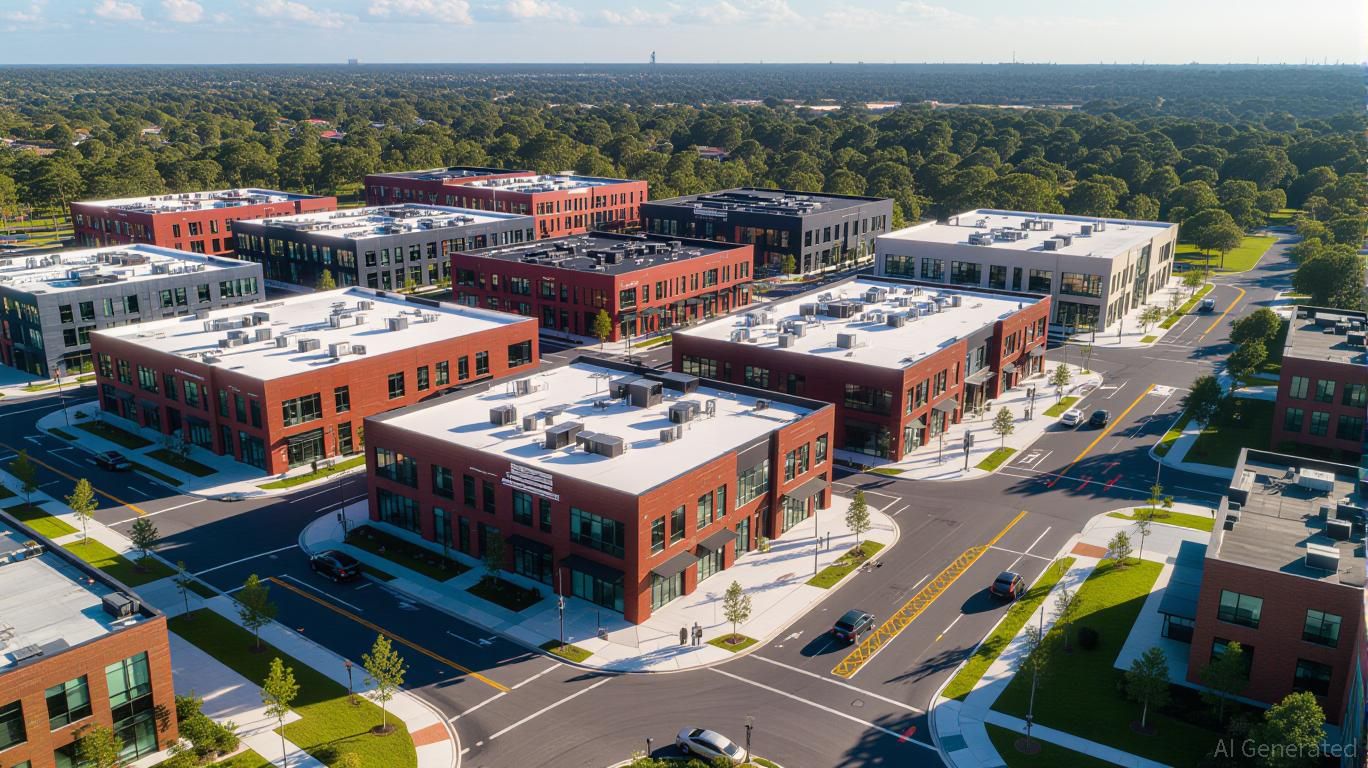Unlocking Potential in Industrial Properties: The Revitalization of Xerox Webster Campus
- Xerox Webster Campus in NY transforms 300-acre brownfield into industrial hub via $9.8M infrastructure upgrades and public-private partnerships. - State-funded projects including road improvements and sewer expansions unlock 1M sq ft of modern industrial space for manufacturing and tech sectors. - Governor Hochul's "sustainable ecosystem" strategy aligns with infrastructure-driven development, attracting semiconductor and renewable energy industries. - Shovel-ready model reduces construction risks, offer
A Framework for Infrastructure-Driven Expansion
Central to the Xerox Webster Campus redevelopment is a $9.8 million FAST NY grant, which has

Scaling Up Through Public-Private Partnerships
The Xerox Webster Campus illustrates how public-private partnerships (PPPs) can help manage risks in large-scale industrial developments. By blending government and private funding, the project overcomes many of the financial and regulatory challenges typical of brownfield projects. For example, the $500,000 federal grant for the Community Access Project shows how
This approach is especially relevant in the current industrial property market. According to a 2025 Clarion Partners report,
Investment Opportunities in Ready-to-Build Markets
The Xerox Webster Campus is part of a broader trend. From 2023 to 2025, industrial real estate investment has increasingly focused on returns tied to infrastructure. While short-term obstacles like softer rents and economic uncertainty remain,
Developers are shifting toward smaller, multi-tenant buildings that provide more stable cash flow and reduce the risks of single-tenant properties
Meanwhile, private equity groups are expanding into infrastructure and private credit to achieve distinct returns
Wider Lessons for Industrial Real Estate
The Xerox Webster Campus redevelopment also demonstrates the value of municipal adjustments in unlocking potential. By updating land use classifications and simplifying permitting, local authorities can speed up industrial growth in areas that have been underutilized. This is especially significant in regions like the Sunbelt and Midwest, where
For REITs and private equity, the message is clear: infrastructure-led development is now a mainstream approach. Clarion Partners points out that
Conclusion
The Xerox Webster Campus redevelopment is more than just a local achievement—it reflects the broader transformation of the industrial real estate sector. By integrating infrastructure upgrades, public-private partnerships, and innovative design, the project shows how industrial properties can be repositioned to address the needs of a post-pandemic economy. For developers, REITs, and private equity, the main lesson is clear: in a time of supply chain shifts and the rise of e-commerce logistics, the best opportunities are found where infrastructure investment and strategic planning intersect.
Disclaimer: The content of this article solely reflects the author's opinion and does not represent the platform in any capacity. This article is not intended to serve as a reference for making investment decisions.
You may also like
The Recent Rise in Astar (ASTR) Value: Unveiling the Driving Forces Behind the Latest Surge
- Astar (ASTR) price surge driven by institutional adoption, robust on-chain metrics, and cross-chain innovation, with TVL rising to $2.38M in Q3 2025. - Astar 2.0's 150,000 TPS throughput and dynamic tokenomics (4.32% inflation) attract institutional investors seeking scalable, stable blockchain solutions. - Partnerships with Sony , Toyota , and others validate Astar's enterprise-grade infrastructure, aligning with crypto-traditional finance convergence trends. - Projected $0.80–$1.20 price target by 2030

Hayes Focuses on High-Yield DeFi Initiatives Amid Growing Institutional Interest
- Arthur Hayes acquired 2.01M ENA , 218K PENDLE, and 33K ETHFI tokens via Cumberland, totaling $1.42M in DeFi projects focused on yield optimization and automated market-making. - The purchases highlight growing institutional interest in DeFi protocols offering structured products and tokenized derivatives, with ENA and PENDLE leading in governance and yield strategies. - Hayes's strategy aligns with leveraging on-chain data to target undervalued assets, potentially amplifying market sentiment but exposing

Bitcoin Updates: Major Institutions Propel Bitcoin Beyond $90K Amid Expanding ETF Investments
- Institutional investors drove Bitcoin above $90,000 in November 2025 through strategic ETF allocations, including Texas's $10M initiative and Harvard's $443M IBIT stake. - ETF flows showed $238M inflows into spot Bitcoin ETFs despite prior $3.5B outflows, reflecting maturing institutional diversification and crypto-friendly government frameworks. - Texas's planned self-custodied Bitcoin transition and Mubadala's tripled IBIT holdings highlighted growing acceptance of Bitcoin as a strategic reserve asset.

Solana News Update: CHOG Soars by $10M—Meme Coin Frenzy Faces Analyst Cautions Over Market Fluctuations
- CHOG, a Monad ecosystem meme coin, briefly hit $10M market cap on Nov 27, driven by $17.9M 24-hour trading volume. - Monad's mainnet launch (Nov 24) raised $269M via a 1.43x oversubscribed Coinbase ICO, attracting 85,000 participants. - Analysts warn meme coins like CHOG face volatility risks due to social media-driven hype and lack of fundamentals. - Meme coin market reached $47.1B in Q4 2025, with DOGE and SHIB leading despite emerging Solana/Monad projects gaining traction. - Institutional investors r
